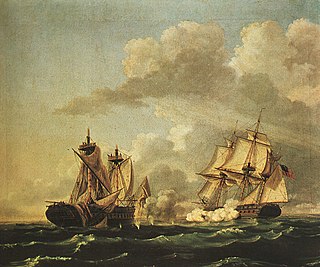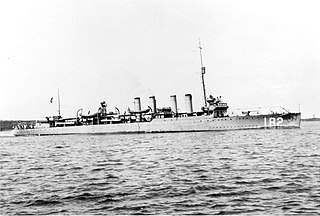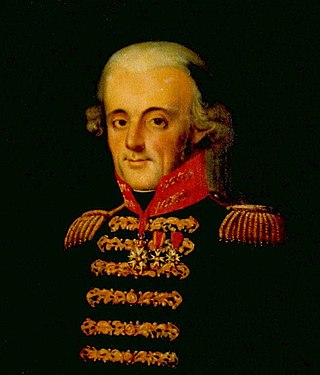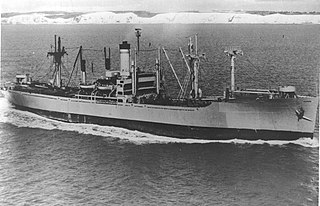
HMS Macedonian was a 38-gun fifth-rate Lively-class frigate in the Royal Navy, later captured by the USS United States during the War of 1812.

HMS Java was a British Royal Navy 38-gun fifth-rate frigate. She was originally laid down in 1805 as Renommée, described as a 40-gun Pallas-class French Navy frigate, but the vessel actually carried 46 guns. The British captured her in 1811 in a noteworthy action during the Battle of Tamatave, but she is most famous for her defeat on 29 December 1812 in a three-hour single-ship action against USS Constitution. Java had a complement of about 277, but during her engagement with Constitution she allegedly had 426 aboard, in comparison with her opponent's 475.

HMS La Hogue was a 74-gun third-rate ship of the line of the Royal Navy, launched on 3 October 1811 at Deptford. She was named after the 1692 Battle of La Hogue. "The La Hogue of 1811 [...] sported a green and chocolate lion, its grinning mouth displaying rows of white teeth and a huge red tongue."

The first USS Thomas (DD–182) was a Wickes-class destroyer of the United States Navy that entered service just after World War I.

The Gunboat War was a naval conflict between Denmark–Norway and Great Britain during the Napoleonic Wars. The war's name is derived from the Danish tactic of employing small gunboats against the materially superior Royal Navy. In Scandinavia it is seen as the later stage of the English Wars, whose commencement is accounted as the First Battle of Copenhagen in 1801.

HDMS Najaden was a frigate in the Royal Danish-Norwegian Navy. She was commissioned in 1811 and originally carried 36 guns, later being upgraded to 42. She served briefly during the Gunboat War only seeing action once, when on 6 July 1812 the British ship of the line HMS Dictator and the Cruizer-class brig-sloop HMS Calypso sank her during the Battle of Lyngør. The Battle of Lyngør effectively ended Denmark's involvement in the Napoleonic Wars.
Five ships and a number of shore establishments of the Royal Navy have borne the name HMS Daedalus, after the mythical Daedalus:

HMS St Albans was a 64-gun third rate ship of the line of the Royal Navy, launched on 12 September 1764 by Perry, Wells & Green at their Blackwall Yard, London.
HMS Algerine was a Pigmy–class 10-gun schooner of the Royal Navy. She was launched in March 1810. She served in the North Sea and then transferred to the West Indies, where she was wrecked in 1813.

HMS Calypso was a Royal Navy Cruizer-class brig-sloop. She was built at Deptford Wharf between 1804 and 1805, and launched in 1805. She served in the North Sea and the Baltic, most notably at the Battle of Lyngør, which effectively ended the Gunboat War. Calypso was broken up in March 1821.

César-Joseph de Bourayne, later Baron Bourayne, was a French naval officer, famous for his battles against British ships in the Indian Ocean and South China Sea. He was appointed Rear-admiral in 1814, having been made a Baron in 1811.
HMS Alban was one of twelve Adonis-class schooners of the Royal Navy and was launched in 1806. She served during the Napoleonic Wars. During the Gunboat War she took part in two engagements with Danish gunboats, during the second of which the Danes captured her. The British recaptured her seven months later, but she was wrecked in 1812.
The action of 15 February 1783 was a small naval engagement of the American Revolutionary War, involving the 36-gun French Navy frigate Concorde and the Royal Navy 74-gun ship of the line Magnificent. The British were victorious when Concorde was overhauled and captured.
Ronco was a French Illyrien or Friedland-class brig built at Venice and launched in April 1808. HMS Unite captured her less than two months later. The Royal Navy took her into service as HMS Tuscan. She served in the Mediterranean and participated in one action that earned her crew a Naval General Service Medal. She was first offered for sale in 1816 and sold in 1818. At that time mercantile interests purchased her and she became a whaler, making six voyages before being condemned as no longer seaworthy in March 1840 and sold in April during her seventh voyage.

Rifleman was a Cruizer-class brig-sloop launched in 1809 for the Royal Navy. She served in the North Sea, on the Halifax and Jamaica stations, and in the Mediterranean Sea. During her service she recaptured a Royal Navy vessel in Danish service, and two privateers. The Navy sold her in 1836 and she proceed to sail as a merchantman and whaler between 1837 and 1856.
Lord Forbes was launched at Chester in 1803 as a West Indiaman. She soon became an "armed defense ship", but by 1805 had returned to being a West Indiaman. She made two voyages as an "extra" ship for the British East India Company (EIC). She continued trading with India until 1817 when she sustained damage on her way to Bengal. There she was surveyed, condemned and sold.
Several ships have been named Auguste:

SS St. Albans Victory was a Victory ship cargo ship built for the U.S. Maritime Commission during the final months of World War II. She was converted to be a troop ship.









